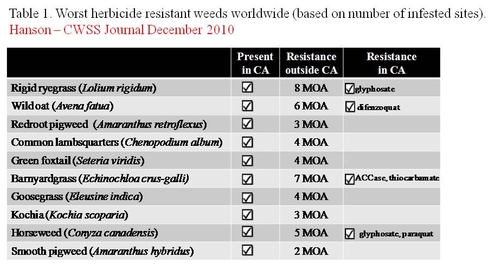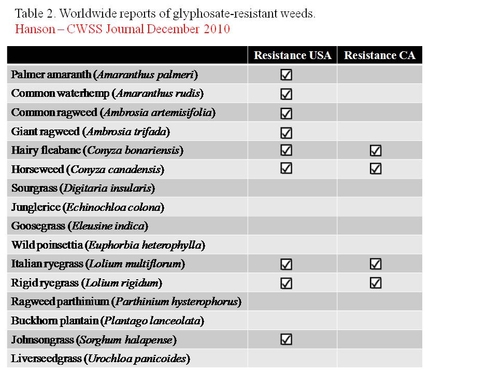This is a reposting of an article I recently wrote for the California Weed Science Society Journal (also reprinted by Western Farm Press). The article is based on a presentation I made at the California Weed Science Society annual meeting in Visalia last January.
Here is a link to the whole issue where you can read several other articles: http://www.cwss.org/PDF/10CWSS%20Fall%202010.pdf
- Herbicide Resistance - An Evaluation of Hard-to-Control Weeds and a Discussion of What Might Be Coming Our Way
- Hairy Fleabane in Central Valley of California, is there anything new in an old known problem?
- Controlling Difficult Weeds in Right of Ways and Non Cropland
- Roundup Ready Canola as a Weed in California
- Evaluation of a Robotic Cultivator for Vegetable Production in California
Herbicide Resistance – An Evaluation of Hard-to-Control Weeds and a Discussion of What Might Be Coming Our Way
Brad Hanson, University of California, Davis,
The development of weed biotypes that are resistant to commonly used control measures is becoming an increasingly significant problem in California and around the world. As of January 2010, there have been 194 confirmed reports of herbicide resistance affecting 19 different herbicide mode of action families (Heap 2010). Of these cases, about 60% are broadleaf and 40% are grass or sedge weeds. In the U.S., 128 resistant species have been reported (also 60% broadleaf weeds) and 15 herbicide families are affected. California has 21 individual cases of resistant weeds impacting 7 herbicide families; however, in contrast to the rest of the world, two-thirds of California’s resistant species are grasses and sedges due primarily to tremendous selection pressure for grass weeds in rice production
When we consider what herbicide resistant weeds might become important in California in the future, we should focus on weeds that already have reports of resistance in other parts of the world. The 10 most important herbicide resistant species in the world (Heap 2010) are all present in California and can be problematic weeds even without herbicide resistance (Table 1). Four of those (three grasses and one broadleaf) are already known to be resistant to at least one herbicide in California. These 10 species have individual reports of resistance to many different modes of action (MOA) and we can expect that new cases may show up in this state over time. Additionally, other important weeds in these genera also are a likely risk for resistance in California (eg. Lolium spp., Amaranth spp., Echinocloa spp., and Conyza spp.).

A relatively recent trend in the development of herbicide resistant weeds has been the discovery of glyphosate-resistant weeds. Although glyphosate (the active ingredient in RoundUp, and others) has been used for nearly 40 years, no resistance was reported until 1996. However, since 1996, sixteen glyphosate-resistant biotypes have been reported around the world (Table 2). Nine of these are already in the U.S. and four are known to be widespread in California. Similar to the earlier discussion, many of these species or close relatives are common throughout the state and are of great concern with regards to losing efficacy of this important broad-spectrum herbicide.

While this discussion is simply one guess as to which herbicide resistant weeds may become problems in California in the future, we can be certain that resistance is likely to remain a significant problem. Rapid and committed adoption of resistance management practices is critical for the preservation of important tools like glyphosate and other herbicides.